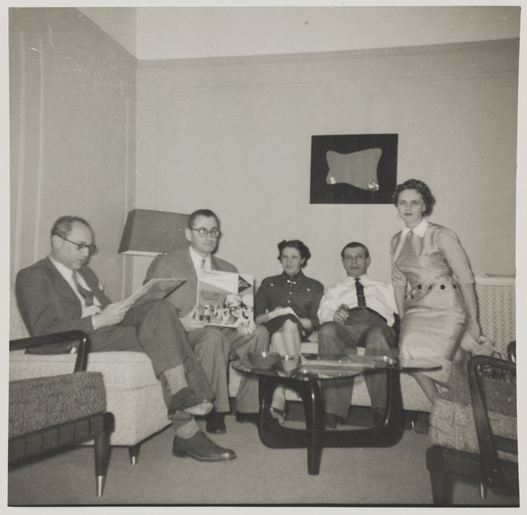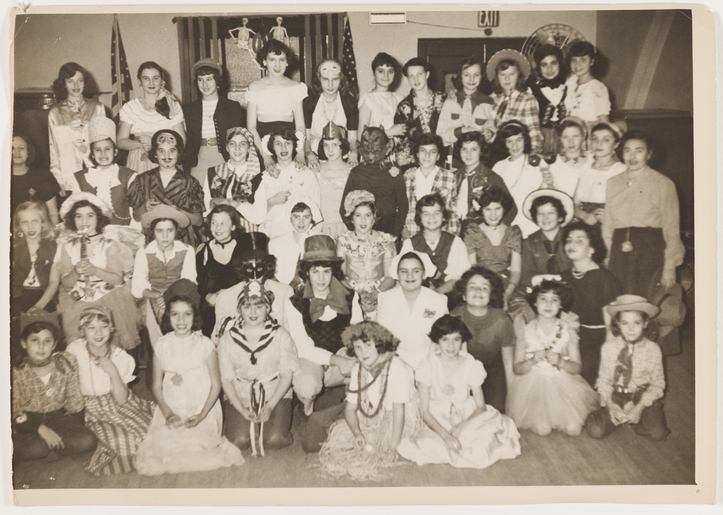At Home in the Heights













With the conclusion of World War II, the disappearance of Jewish communities in Europe, and the fragility of life in Palestine, refugees became even more committed to America. For refugees that served the US in the War, returning to America had newfound meaning. Those who had once imagined a possible return to Europe after the War settled more deeply into New York and became US citizens in the 1940s. The refugee community at large became more acculturated overall, while still retaining much of its German-Jewish distinctiveness.
COMMUNAL LIFE
In most respects, life for refugees in New York was easier after World War II. Newcomers had a better command of English, careers were more firmly established, the job market was more promising, and the fruits of the New Deal were more palpable. With a more stable existence in the post-war years, the German-speaking Jews of Washington Heights were able to build and strengthen institutions that served their religious needs as well as their cultural needs—both as German immigrants and as new Americans.
BUILDING RELIGIOUS INSTITUTIONS
Most German-Jewish refugees in the Heights chose to pray, study, and observe with their own minyanim. Though they were certainly aware of the extant East-European congregations already in the neighborhood, most newcomers did not feel comfortable worshiping in them given differences in religious observance, language, and traditions.
Congregations founded by refugees started with modest gatherings in informal spaces and basements. Over the years, they grew in size and stability, and built their own modern facilities.
There were four main religious divisions within the community of German and Austrian Jews in Washington Heights: Separatist Orthodox, Traditional Orthodox, Conservative, and Reform.
K’HAL ADATH JERSHURUN, THE BREUER COMMUNITY
K’hal Adath Jershurun was founded in Frankfurt by Rabbi Samson Raphael Hirsch. About one third of the community members escaped Nazi persecution in Germany and settled in Washington Heights. With modest means, the community was reestablished by Rabbi Joseph Breuer (Hirsch’s grandson) in 1939 in rented quarters. The congregation remained faithful to the separatist principles of its founder, including the rejection of religious reform, opposition to Zionism, strict adherence to Jewish law, and a focus on traditional text.
Hirsch’s motto was “Torah im Derech Eretz”, which described a philosophy that encouraged full participation in the modern world without any compromise in observance of Jewish law.
The congregation grew in size and stature in the 1940s, and it remains a vital part of Washington Heights today.

REFLECTING OLD AND NEW
Though most German-Jewish residents of Washington Heights lived in the same neighborhood pockets as their Jewish predecessors, they created their own network of institutions—including a dozen new synagogues between 1935 and 1949.
Many refugees came from observant communities in Europe and retained their practices in America. Their new conservative congregations usually continued the German tradition of “liberales Judentum”—recognizing that observance and opinion varied from person to person and was shaped by individual preference. Quite a few of the new synagogues reflected religious practices from Germany and Austria, and thus preserved a culture being destroyed in Europe.
Hebrew Tabernacle, a Reform congregation founded by German-Jews in 1906, welcomed many new members from among the refugees, who may have sought it out because it still incorporated European traditions including German liturgical music.
YESHIVA UNIVERSITY
Along with the influx of Jewish immigrants from Eastern Europe to New York in the 1880s came the need for an American yeshiva. Initially established as a cheder-style school and then a seminary, the organization became Yeshiva College (later a University) and moved from the Lower East Side to Washington Heights in 1928.
For many years the relationship between the University and the German-speaking refugees in Washington Heights was distant and even competitive. The Breuer Community criticized the University’s approach to text study and Zionism, while University leaders saw the Breuer Community and local refugees as nontraditional.
Though just a small percentage of the student population, German students at the University created a Deutscher Verein (German Society). These students were usually born in Germany and did not grow up in Washington Heights; through the Verein they found each other and participated in social activities.

